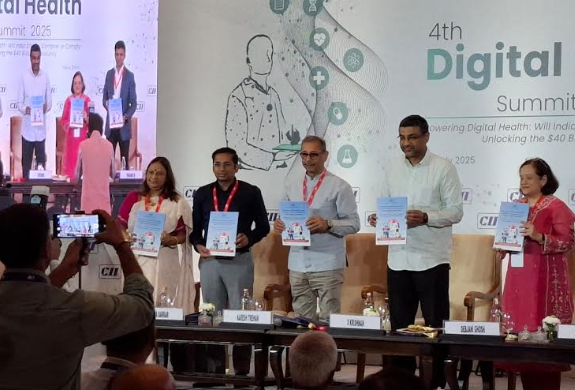Wellness is No Longer a Cost, Its Capital: CII–MediBuddy Report Maps Corporate India’s Digital Health Readiness

25 July 2025 – MediBuddy, India’s largest digital healthcare company, in collaboration with CII, today unveiled the second edition of its corporate wellness report, marking a continued effort to decode the evolving landscape of employee well-being in India Inc. The latest edition, titled Workplace Health Reimagined: Corporate India’s Readiness for Digital Health Leadership, highlights how employee wellness is evolving from a peripheral initiative to a strategic lever for workforce productivity, talent retention, and business continuity.
India’s healthcare and workplace wellness landscape is undergoing a significant transformation, with wellness emerging as a national priority in the journey towards Viksit Bharat 2047. This is being shaped by rising medical inflation (14%), increased chronic disease risk, a digitally empowered workforce, and growing demand for inclusive and preventive care models. In a post-pandemic world, where hybrid work models have become the norm, organisations are rethinking wellness, placing equal weight on physical and mental health, and moving from episodic to always-on care models. Technology is at the heart of this transformation; AI-driven insights, data-enabled personalisation, and mobile-first platforms are enabling more impactful care delivery. The nation’s digital health infrastructure demonstrates remarkable scale. Public health initiatives such as the Ayushman Bharat Digital Mission (ABDM) and the IRDAI’s push for 100% cashless insurance claims are further accelerating the shift toward digitally integrated, OPD-first healthcare systems. Together, digital infrastructure and insurance are proving to be critical enablers of equitable, future-ready wellness delivery across India.
The report reveals a stark reality of over 70% of employees carrying at least one lifestyle-related health risk, yet only 20% of employers providing routine health screenings. This alarming scenario calls for a shift from episodic, event-based health programs to always-on, digital-first ecosystems that drive workforce productivity, talent retention, and business continuity, all fostering business growth in today’s evolving times of shifting workforce priorities.
Key findings/highlights from the report:
Macro View: The National Wellness Landscape
- Rising Burden of NCDs: Non-communicable diseases now account for 63% of all deaths in India, with heart disease, diabetes, and stroke impacting the workforce at median ages of 32, 34, and 36, respectively.
- Healthcare Infrastructure Crisis: The doctor-to-population ratio remains below WHO guidelines, with 70% of Indians in rural/semi-urban areas facing significant access barriers to diagnostics and routine care
- Healthcare Coverage Crisis: Only 41% of Indian households have any form of health insurance, leaving over 50 crore people, belonging largely from India’s 40-crore “missing middle” population, particularly comprising gig, daily wage, and informal workers, vulnerable to catastrophic health expenses
- Low OPD Insurance Penetration: OPD insurance penetration in India remains below 0.1%, a significant gap compared to over 85% in the US and 95% in Singapore, leaving most outpatient expenses uncovered, despite OPD accounting for nearly 70% of out-of-pocket healthcare spending
- High Out-of-Pocket Spending: OOPE accounts for 63% of India’s total health spend
- Within Workplaces: The Corporate Lens
- Productivity Loss: Presenteeism and chronic illnesses cost Indian companies up to ₹1.12 lakh per employee annually, while structured wellness programs deliver a 3–4x return on investment
- Limited Access to Diagnostics: Less than 20% of corporate health programs cover essential diagnostics, despite their role in 60–70% of clinical decisions
- Low Preventive Screening for Women: Only 1.9% of eligible Indian women undergo cervical cancer screening, and just 36% of corporates provide targeted wellness benefits for women
- Gaps in Women-Centric Benefits: Just 36% of corporates offer targeted wellness benefits for women, with even fewer extending support for eldercare and mental health
- Lifestyle Risks and Screening Gaps: Over 70% of employees have at least one lifestyle-related risk factor, yet only 20% of employers provide routine health screenings
- SMEs Lag in Wellness Coverage: Although SMEs employ over 111 million people, only 9% offer structured wellness programs
- Corporate Wellness Readiness: India’s average Corporate Wellness Quotient (CWQ) score stands at 55/100, with fewer than 15% of companies achieving a ‘Mature’ wellness readiness level
Satish Kannan, Co-founder & CEO, MediBuddy, said, “India’s journey towards becoming a Viksit Bharat by 2047 cannot rest on economic metrics alone; it must be built on the health, productivity, and well-being of its people. As we stand at this inflection point, employee wellness can no longer be treated as an optional benefit but must be considered a strategic imperative. With rising health risks and evolving workforce expectations, this report in collaboration with CII offers actionable insights and data-driven frameworks to help organisations transition from annual health camps to always-on, digital-first ecosystems. At MediBuddy, we are happy to support this transformation by delivering care that is proactive, personalised, and powered by technology.”
Insights from the report: Trends reshaping care culture
The report highlights how employee wellness in India is moving beyond one-size-fits-all health programs to more integrated, inclusive, personalised, and digitally powered wellness solutions. Employees now expect benefits that reflect their life, role, and risk profile across domains such as mental health, chronic care, eldercare, and preventive screenings. At the same time, employee engagement is being increasingly driven by features such as gamified health journeys and wellness wallets. Additionally, mobile-first platforms and OPD access for dependents are now becoming differentiators in how employees engage with corporate wellness programs, with inclusion-focused benefits becoming key in addressing diverse workforce needs.
To direct this shift, the report introduces the Corporate Wellness Quotient (CWQ), an original and comprehensive benchmarking tool measuring digital wellness maturity and readiness across four pillars: access & affordability, policy integration, digital enablement, and employee engagement; and the ten-step wellness blueprint, which offers companies a strategic roadmap to build resilient and inclusive care ecosystems.

